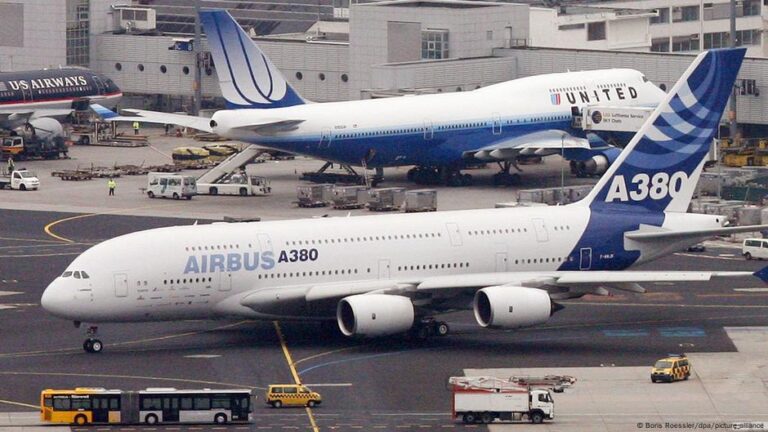Air travel is widely regarded as the safest way to cover long distances. Statistically, the drive to the airport poses a greater risk to travelers than the flight itself.
But when there is a plane crash — such as that of Air India Flight 171 last week (June 12) — statistics offer little comfort. It killed 270 people, including 241 of the 242 people on board.
As tragic as such accidents are, their consequences also extend into the economic realm. Alongside efficiency and environmental compatibility, operational safety remains the most critical selling point for a passenger aircraft.
Airbus takes the lead
For decades, Boeing was the global leader in commercial aviation. But in recent years, the company, which is based in Arlington, Virginia and employs 170,000 people, has struggled, often posting losses.
In 2024, itreported an operating loss of nearly $11.8 billion (€10.21 billion) on revenue of $66.5 billion.
It delivered 348 commercial passenger airplanes — a decrease compared to the 528 deliveries in 2023. The downturn is attributed to challenges that include a mid-air door plug blowout in January and a machinist strike in the fall, as well as ongoing supply chain issues.
Boeing’s deliveries last year were significantly lower than those of its rival Airbus, which delivered 766 aircraft.
Airbus, which has about 160,000 employees, posted an operating profit of around €5 billion ($5.78 billion) on revenue of €69.2 billion in the same period.
However, production and sales figures for commercial aircraft only tell part of the story. Both companies are also active in space systems and defense manufacturing, which makes direct comparisons more complex.
Bad luck and blunders
The Air India crash is just the latest setback for Boeing’s safety record. In recent years, the American company has stumbled from one mishap to the next, repeatedly dealing with technical failures and production snags.
One of the clearest signs of Boeing’s ongoing woes, especially compared to Airbus, is how each company handled its largest aircraft.
For Airbus, that was the A380, the largest passenger aircraft ever built. Airports around the world had to update infrastructure such as terminals, gates, and handling capacity just to accommodate the double-decker giant.
But Airbus ceased production in 2021, after it became clear that many airlines found the A380 too large and expensive to operate. With four engines, the aircraft was costly to maintain. In addition, with seating for between 500 and 850 passengers, it was difficult to fill, making it economically risky.
From Dreamliner to nightmare
Boeing took a different approach. After ending production of the iconic but outdated 747 Jumbo Jet, Boeing aimed to offer a competitive alternative to the A380 by developing the 787 — nicknamed the Dreamliner — based on an evolution of the 767.
While Airbus quietly phased out the A380, Boeing found itself mired in negative headlines about the Dreamliner. There were issues with new composite materials and coordination failures with suppliers. Test flights were canceled, first flights delayed, and delivery deadlines missed.
Then came safety concerns. In 2013, shortly after the first Dreamliners had entered service, two separate incidents involving battery fires led to the aircraft being grounded worldwide.
Subsidy disputes
The rivalry between Airbus and Boeing has been ongoing since Airbus’s official founding in 2000 under the name European Aeronautic Defence and Space Company (EADS). Their battle for market dominance has even drawn in the World Trade Organization (WTO) and the governments of both the US and Europe.
At the heart of the conflict was a dispute over who gets more in government subsidies — and are those subsidies justified.
That’s a nearly impossible question to answer. While only one federal government is involved in the US, there are several players in Europe — the Netherlands, the UK, France, Spain, Germany, and the European Commission in Brussels.
Adding to the complexity is the fact that both firms also compete in space and defense. While neither tops the global rankings in defense contracting, Boeing ranks sixth among the world’s largest defense companies, well ahead of Airbus, which sits at number 13. Still, both are major players.
The challenge for the two defense contractors is that both rely heavily on government contracts, which don’t just fund research and development, but governments are also their biggest customers. That makes it hard to quantify subsidies or assign them clearly to one business segment.
Duopoly faces fresh competitor
Brazil’s Embraer focuses solely on smaller regional aircraft. Canada’s Bombardier, based in Montreal, has shifted entirely to the niche market of business jets.
That leaves China, one of the world’s largest aviation markets, which now has a homegrown aircraft manufacturer worth watching: the Commercial Aircraft Corporation of China, or Comac.
Founded in Shanghai in 2008 with backing from the Chinese government, Comac unveiled the first model of its C919 in 2015 — a twin-engine passenger aircraft entirely assembled in China.
In partnership with Russian aerospace and defense company UAC, Comac plans to develop a long-range version, the C929, by 2028.
At least until then, the market for wide-body commercial aircraft will continue to be dominated by the two titans from the US and Europe.
This article was originally written in German.


